Editor of this issue: Jonas Zdanys
Copyright © 1986 LITUANUS Foundation, Inc.

|
LITUANUS
LITHUANIAN QUARTERLY JOURNAL OF ARTS AND SCIENCES
Volume 32, No. 1 - Spring 1986
Editor of this issue: Jonas Zdanys ISSN 0024-5089
Copyright © 1986 LITUANUS Foundation, Inc. |

|
ALKA PRESERVES MATERIAL OF LITHUANIAN CULTURE
DR. JUOZAS KRIAUČIŪNAS
Lithuanians have cherished their unique culture through the ages. This national culture finds expression in customs and traditions, life styles and especially in folklore, songs and art. The character of a nation's art may be exemplified in such varied expressions as national costumes, weaving, jewelry and decorations, woodworking and utensils of kitchen and other household use with special decorative finishing. Artists and writers often incorporate characteristics of national folk art into their creations while architects and builders adapt it in their works.
Sometimes, this continuation of a cultural heritage in a foreign environment has uncommon results. For instance, Lithuanian immigrants who arrived in the United States in the late 19th century and the early years of this century continued to build their churches with two steeples rather than the single spire which was customary in this country.
Newly-arrived Lithuanian immigrants in the United States attempted not only to maintain their national culture but to further develop it because the freedom in this country permitted it, while the czarist Russian regime suppressed it.
Their offspring, however, being born and reared in this country, usually became integrated into their environment, losing their ethnic heritage. In this manner, many culturally-related customs and objects were lost or destroyed.
Even during this time, however, there were a few Lithuanians who not only wanted to preserve their national culture and its treasures but who also wanted to show their fellow citizens of other heritages that the Lithuanian heritage was in no way inferior even to the most advanced cultures. One of these rare preservers of the Lithuanian heritage was the Catholic priest, Pranciškus Mykolas Juras. Shortly after his ordination in 1922 he began collecting Lithuanian Catholic books, magazines, and newspapers which were published in America. A few years later, he expanded his collection by including lay publications published in Lithuanian. From time to time, he was asked to show his growing collection in displays and exhibits.
As his experience with these displays grew, he found that he could increase their interest to a larger audience by including items of folk art. In time, the displays of his collection, in addition to printed material, included: weavings and knitting; national folk costumes; dolls in national folk costumes; jewelry and decorations; wood carvings; and various kitchen, home and farm implements and utensils, some of the latter in miniature. Father Juras discovered that, as his collection became larger and more varied, it attracted the growing attention of Americans and nostalgic memories of people born in Lithuania.
Father Juras' collection grew even more with the addition of printed material in other languages about Lithuania or its people. At about the same time, Reverend Juras began collecting works of art such as paintings, rugs and sculpture created by Lithuanian artists. While many of these works were gifts from the artists, others were paid for from personal funds.
Reverend Juras initially named his collection the American Lithuanian Catholic Archives. Toward the end of his life, on the advice of many Lithuanians, the name was changed to the American Lithuanian Cultural Archives, and, based on its Lithuanian name, uses the acronym ALKA.
At first, Reverend Juras' collection was not large and required relatively little storage space. As it grew, particularly with the absorption of the library of the Lithuanian Catholic Federation, the lack of permanent storage space required its cumbersome movement from one temporary storage site to another. Finally, after Father Juras became pastor of the Lithuanian parish in Lawrence, Mass., and after he was later elevated to Monsignor, he was able to use his rectory as the museum site, which in time became overcrowded with books and artifacts.
In 1962-63, Monsignor Juras erected a building for his collection in Putnam, Connecticut. The site of this building adjoins the convent of the Sisters of the Immaculate Conception.
This new permanent display space enabled Monsignor Juras to significantly enlarge his collection. Particularly noteworthy additions were many items which had been on display in the Lithuanian pavilion at the 1939 World's Fair in New York. These items were procured by the government of then independent Lithuania and through the efforts of many Lithuanians who lived in America.
After a few years, the new building which housed Monsignor Juras' collection once again became crammed as the collection began accepting entire libraries of Lithuanian activists living outside of Lithuania, archival material, and personal papers and manuscripts of noted Lithuanians. At present, ALKA contains many items which were formerly owned by such distinguished Lithuanians as Consul Shallna, the Reverend Karalius, the Reverend Yla, the newspaper editors J. and V. Sirvydas, the Reverend Krupavičius, the writer Giedrius and others.
With the passage of time the collection grew to include various records and documents of Lithuanian organizations such as BALFAS, Ateitininkai, Scouts, and others. The number of gifts, artifacts, paintings, books, magazines and newspapers (new and old) also continued to increase. Notable among the artifacts are wood carvings by Mrs. Motuzas and Končius.
In 1974, Monsignor Juras, at that time over 80 years of age, made a gift of the ALKA building and its valuable contents to the Lithuanian Catholic Academy of Science. By this time, the ALKA building had again become crowded with a growing number of books, documents, paintings and artifacts so the expansion became necessary. The Academy then organized a committee to raise funds needed for expansion and a Directorate whose dual purpose was to care for the existing building and contents of ALKA and to plan the expansion. Dr. Alfonsas Stankaitis was elected President of the Directorate.
The fund-raising committee included a number of active Lithuanians concerned with maintaining their national heritage. Committee members were drawn from the U.S., Canada and several other countries. The committee energetically conducted drives for donations during which Mr. J. Vembrė took an especially active role.
In the meantime, the Directorate of ALKA decided on a plan to construct an additional building adjoining the present one and to make the necessary alterations to join the two buildings into one. The plan included a special purpose basement in the new building to house the archives.
Construction could not be rushed during the fund raising and planning stages because sufficient money had to be accumulated. Ultimately, the fund was successful and an addition was built to the ALKA facilities which enlarged the display and storage area more than two and one-half times its former size. Dr. A. Matukas supervised the construction, which was completed in 1981.
The sorting and shelving of printed material and of artifacts and the selecting of the art objects for display is a continuing activity which is supervised by Reverend R. Krasauskas, who performed a similar function in the old ALKA building, and by Dr. J. Kriaučiūnas.
The old building facilities house the museum and displays of art and artifacts. Adjoining the museum is a room sponsored by Dr. J. Balys which contains manuscripts, printed material of folklore, and folk songs.
Most of the main floor area of the new addition is occupied by the library, while the basement houses the archives. The basement also contains rooms for the archives of the Knights of Lithuania (Vyčiai), BALFAS, and the Christian in Life section of the Lithuanian Catholic Academy of Science. A separate room is dedicated to Monsignor P. Juras and Reverend S. Yla.
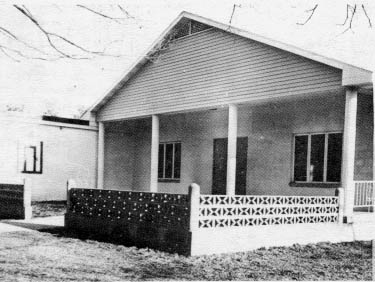
Entrance to ALKA.
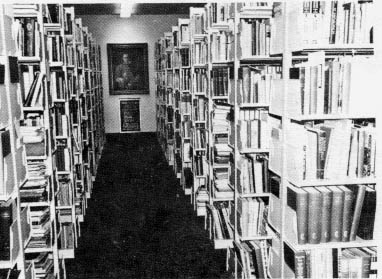
Part of ALKA's library.
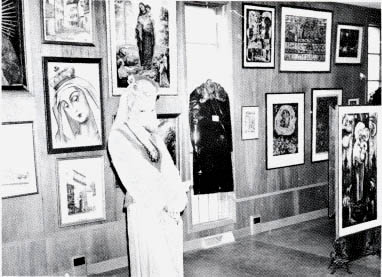
ALKA's exhibits in the museum.
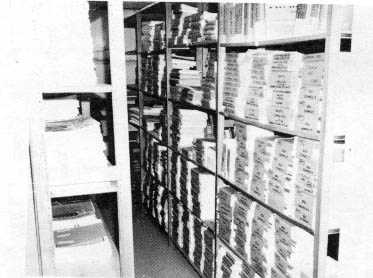
Old magazines and newspaper housed in the basement of ALKA.
The ALKA building has an area of 8,000 square feet, which probably makes it the largest Lithuanian museum archives in the United States.
The walls of the museum portion display dozens of paintings by various Lithuanian artists, some of which are the size of an entire wall of an average home. Also exhibited in this room are sculptures, decorative rugs, and portraits of noted Lithuanians. Shelves and cabinets display Lithuanian handiwork such as weaving, knitting, decorative articles, Easter eggs, and wood carvings. Also displayed are bank notes and coins of independent Lithuania, medals, and miniature as well as full-sized home and farm implements and utensils.
The library contains 80 sets of shelves which are connected and arranged in rows. These shelves contain some 60,000 books ranging from very old editions to those which are new, and more recent Lithuanian magazines and newspapers as well as printed material in other languages about Lithuania and its people. Older newspapers are in the basement archives section.
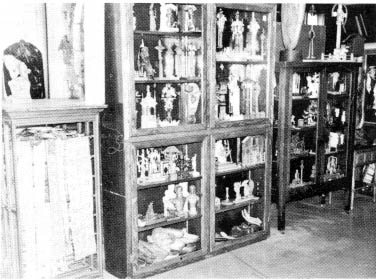
Exhibits of wood carvings in ALKA.
The basement houses primarily archival material which is stored in metal cabinets. Several of these cabinets were donated by the Lithuanian activists whose works they contain. The material stored in the archives is available to those who wish to use it.
The greatest present challenge is to catalogue the books and other printed material, which will then be followed by a cataloguing of all other material. This will facilitate the use of all available material by those wishing to do so. Attempts are being made to find a librarian to catalogue all present material and a person to enter this information into a computer. Contacts have been made with the World Lithuanian Archives and with the Lituanistic Institute, both of which have already catalogued many books present in their possession.
Work remains to be done to assure the continuing significance of ALKA in American-Lithuanian cultural life. The collection of both old and new published material, works of art, and other artifacts needs to be enlarged or completed. There is also an ongoing effort to raise funds to continue and enhance present activities. Both of these efforts will guarantee that ALKA will continue to preserve valuable cultural material and serve as a comprehensive center for scholarly research.